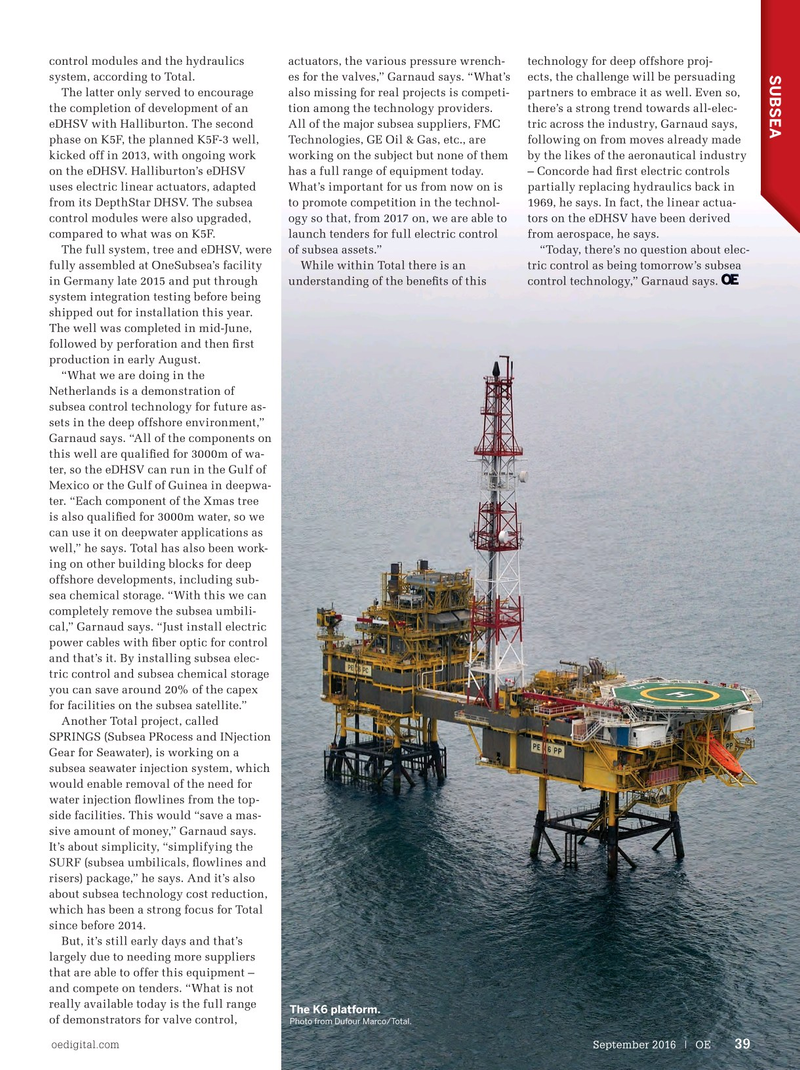
Page 37: of Offshore Engineer Magazine (Sep/Oct 2016)
Read this page in Pdf, Flash or Html5 edition of Sep/Oct 2016 Offshore Engineer Magazine
control modules and the hydraulics actuators, the various pressure wrench- technology for deep offshore proj-
SUBSEA system, according to Total. es for the valves,” Garnaud says. “What’s ects, the challenge will be persuading
The latter only served to encourage also missing for real projects is competi- partners to embrace it as well. Even so, the completion of development of an tion among the technology providers. there’s a strong trend towards all-elec- eDHSV with Halliburton. The second All of the major subsea suppliers, FMC tric across the industry, Garnaud says, phase on K5F, the planned K5F-3 well, Technologies, GE Oil & Gas, etc., are following on from moves already made kicked off in 2013, with ongoing work working on the subject but none of them by the likes of the aeronautical industry on the eDHSV. Halliburton’s eDHSV has a full range of equipment today. – Concorde had ? rst electric controls uses electric linear actuators, adapted What’s important for us from now on is partially replacing hydraulics back in from its DepthStar DHSV. The subsea to promote competition in the technol- 1969, he says. In fact, the linear actua- control modules were also upgraded, ogy so that, from 2017 on, we are able to tors on the eDHSV have been derived compared to what was on K5F. launch tenders for full electric control from aerospace, he says.
The full system, tree and eDHSV, were of subsea assets.” “Today, there’s no question about elec- fully assembled at OneSubsea’s facility While within Total there is an tric control as being tomorrow’s subsea in Germany late 2015 and put through understanding of the bene? ts of this control technology,” Garnaud says. system integration testing before being shipped out for installation this year.
The well was completed in mid-June, followed by perforation and then ? rst production in early August.
“What we are doing in the
Netherlands is a demonstration of subsea control technology for future as- sets in the deep offshore environment,”
Garnaud says. “All of the components on this well are quali? ed for 3000m of wa- ter, so the eDHSV can run in the Gulf of
Mexico or the Gulf of Guinea in deepwa- ter. “Each component of the Xmas tree is also quali? ed for 3000m water, so we can use it on deepwater applications as well,” he says. Total has also been work- ing on other building blocks for deep offshore developments, including sub- sea chemical storage. “With this we can completely remove the subsea umbili- cal,” Garnaud says. “Just install electric power cables with ? ber optic for control and that’s it. By installing subsea elec- tric control and subsea chemical storage you can save around 20% of the capex for facilities on the subsea satellite.”
Another Total project, called
SPRINGS (Subsea PRocess and INjection
Gear for Seawater), is working on a subsea seawater injection system, which would enable removal of the need for water injection ? owlines from the top- side facilities. This would “save a mas- sive amount of money,” Garnaud says.
It’s about simplicity, “simplifying the
SURF (subsea umbilicals, ? owlines and risers) package,” he says. And it’s also about subsea technology cost reduction, which has been a strong focus for Total since before 2014.
But, it’s still early days and that’s largely due to needing more suppliers that are able to offer this equipment – and compete on tenders. “What is not really available today is the full range
The K6 platform. of demonstrators for valve control,
Photo from Dufour Marco/Total. oedigital.com September 2016 | OE 39 038_OE0916_Subsea1_K5F.indd 39 8/24/16 1:00 PM

 36
36

 38
38